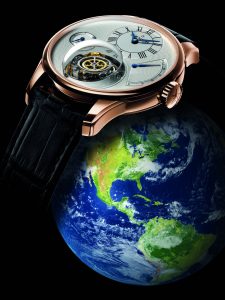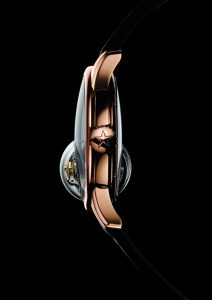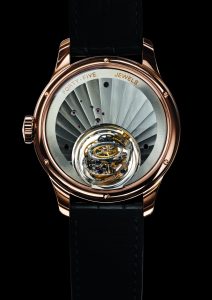Reviews
Zenith Christophe Colomb
Zenith recalls the pioneering days of exploration with its tourbillon alternative
In 1916, Zenith produced a new escapement called the Echappement Colon — Colón being the Spanish word for Columbus, and échappement the French word for escapement. This Lépine-style chronometer movement was 20½ lines in size and was awarded three first prizes by Neuchâtel’s observatory and an “especially good” Class A certificate by the Kew Observatory in Teddington, UK.
Columbus, however, lived two centuries before John Harrison, so he did not benefit from the more precise style of navigation Harrison’s H4 made possible; instead, like his contemporaries, Columbus used celestial navigation. As we know, this type of navigation was not always as reliable as one would have liked — which turned out to be a blessing for Columbus. For if he had really reached India as he thought he was going to, he would never have been credited with discovering the New World, which he did quite by accident. When Columbus reached the southern islands skirting what is now known as North America, he thought he had indeed reached India via a newer, shorter route. This is why those islands became known as the West Indies and America’s indigenous people were called “Indians”.
Paying homage to Columbus as well as marine chronometers, the escapement of Zenith’s present-day Christophe Colomb is gimballed on what’s known as a Cardan suspension to ensure maximum precision in any position.

The Zenith Christophe Colomb watch is gimballed on a Cardan suspension to keep the regulating organs constantly horizontal, no matter how the wrist is positioned, thus improving accuracy.
Rolling Precision
The Cardan suspension was used to keep shipboard timekeepers in the same horizontal position no matter how badly the ship itself rolled and pitched. This universal joint shaft simply rotates its precious cargo when its environment is out of alignment. It is named for 16th century mathematician Girolamo Cardano — who left behind a written description but did not claim to have invented it, and who was inspired by a sedan chair made for Emperor Charles V that could compensate for the slope of various terrains, thereby ensuring the sovereign’s chair would remain flat and stable under every circumstance.
Zenith’s engineers chose to put the escapement they had been working on (under the guidance and leadership of Zenith’s head movement designer Yves Corthesy) on a Cardan suspension so that it could remain in the same position — and therefore exhibit the same effective rate of -1 second per day, regardless of the position of the wearer’s wrist.
Not a Tourbillon
This highly sophisticated system surrounding the escapement seeks to compensate for gravity’s effects without using a classic tourbillon as the solution. This solution may improve on the tourbillon in two respects: first, it guards against positional error in any position, not just the vertical ones; and secondly, rather than creating an average error rate for all vertical positions, it simply prevents positional error from occurring in the first place.
The gimballed suspension keeps the Zenith escapement in a consistently horizontal position, gyroscopically lending it a slightly stabilizing effect. In other words, it follows the position of the wrist and corrects the effects of gravity in a perfectly natural way.
The latter is possible thanks to Zenith’s patented 0G system, which stands for “zero gravity”. A system of gears harnesses the rotations of the carriage’s axes, while a reversing differential gear instantaneously compensates for movement. The escapement is located within the carriage, constantly seeking out balance and equilibrium that is determined by gravity.
Unlike a tourbillon, which moves along a predetermined course of its own accord at a preset speed, the 0G system simply counteracts by keeping the escapement upright.
Supreme Accuracy
This escapement and its suspension are prominently visible, housed within sapphire-crystal domes on both sides at the six o’clock position to accommodate the gyroscopic escapement module. The suspension has a total of 166 components, including 10 conical gear wheels, six spherical wheels, and six ball bearings: defying gravity, it ensures an even rate and thus better-than-chronometer accuracy.
In fact, in all six regulated positions, the manually wound calibre Academy 8804, which beats at Zenith’s hallmark frequency of 36,000vph and boasts 50 hours of power reserve, shows no rate variation at all on a Witschi timing machine. In five of the positions, it is regulated to -1 second per day, while in the sixth position it is regulated to a zero delta.
While a standard tourbillon creates an average of all errors in the four vertical positions, the 0G system was created to actually prevent any positional rate error from occurring in any position.
Classic styling
This exquisite collector’s piece, limited to just 25 pieces, is housed in a traditionally styled 45mm case of 18k white, yellow or rose gold. Underscoring the traditional look is a solid silver dial with a handcrafted guilloché grain d’orges pattern enhanced by a clous de Paris pattern on the subsidiary seconds dial.
Zenith Christophe Colomb
MOVEMENT Academy 8804 manually wound movement with unique gyroscopic system; 50-hour power reserve
CASE 45mm; white, rose or yellow gold; water resistant to 30m
STRAP Black crocodile leather
Excerpted from an article by Elizabeth Doerr, co-founder of Quill & Pad, in REVOLUTION’s archives.












